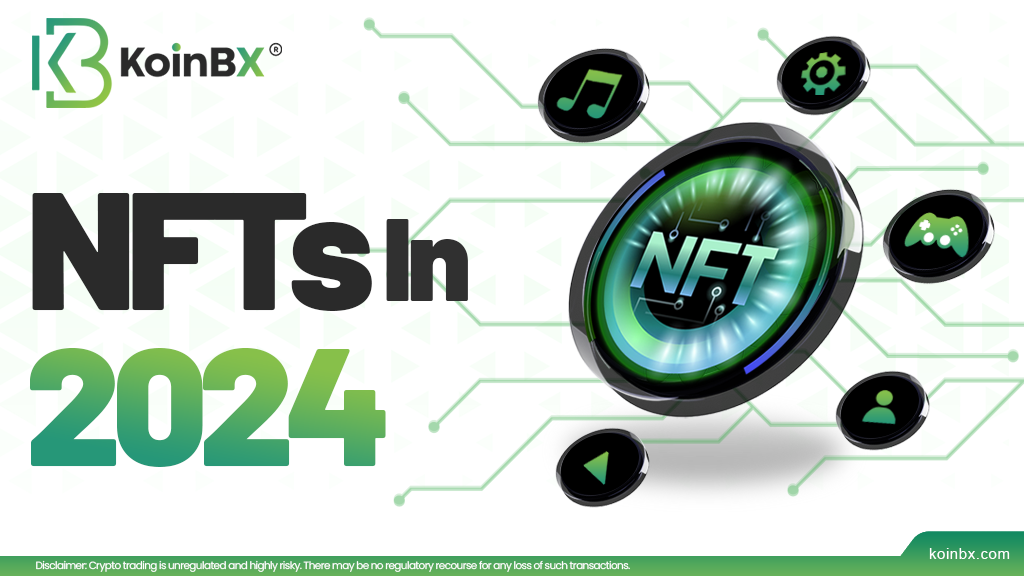Introduction
Non-Fungible Tokens (NFTs) have transcended their origins as digital art assets, evolving into a multifaceted and dynamic technology with applications across various industries. As we enter into 2024, this article explores the expansion of NFTs, explains their diverse applications beyond digital art, and examines the promising future prospects.
The Evolution of NFTs
Non-fungible tokens (NFTs) are one-of-a-kind digital assets that are validated on the blockchain. While Bitcoin and Ethereum are fungible digital assets that can be exchanged one-on-one, NFTs are unique.
NFTs initially gained popularity in the digital art world, providing artists with a new way to make money from their work and allowing collectors to own a piece of digital art. Artists and creators embraced NFTs as a revolutionary way to tokenize and monetize their work, introducing a new paradigm for the art market. However, the potential of NFTs extends far beyond the confines of the art world.
NFTs Beyond Digital Art
Real Estate and Property Ownership
NFTs are making significant inroads into the real estate industry. By tokenizing properties, ownership and transfer of real-world assets become more efficient and transparent. NFTs can represent deeds, titles, and other property-related documents, simplifying the real estate transaction process and reducing the need for intermediaries.
Gaming and Virtual Assets
In the gaming world, NFTs have become a game-changer. Gamers can truly own and trade in-game assets as NFTs, fostering a vibrant virtual economy. This extends to virtual real estate, where digital spaces within games can be bought and sold as NFTs, creating new opportunities for both players and developers.
Music and Intellectual Property
Musicians and artists are exploring NFTs as a means to tokenize their music and intellectual property. NFTs can represent ownership of music rights, concert tickets, and limited editions of albums. This not only provides artists with new revenue streams but also enhances the fan experience through unique and exclusive offerings.
Collectibles and Memorabilia
Beyond digital art, NFTs are transforming the world of collectibles and memorabilia. Whether it's virtual trading cards, rare digital stamps, or iconic moments in sports, NFTs provide a secure and verifiable way to authenticate and trade these items in the digital world.
Education and Certification
NFTs are finding applications in education by tokenizing academic credentials and certifications. This ensures the immutability and authenticity of educational achievements, making it easier for employers and institutions to verify an individual's qualifications.
Future Prospects of NFTs
Interoperability and Standardization
In 2024, the NFT space is likely to witness increased interoperability among different blockchain networks. Efforts to standardize NFTs and ensure cross-chain compatibility will make it easier for users to move assets seamlessly between platforms, unlocking new possibilities for collaboration and innovation.
Environmental Sustainability
Addressing environmental concerns associated with blockchain networks, particularly proof-of-work-based systems, will be a key focus. NFT platforms are expected to explore and adopt more sustainable consensus mechanisms, such as proof-of-stake, to mitigate their ecological impact.
Enhanced Smart Contracts and Utility
The development of more sophisticated smart contracts will bring increased utility to NFTs. Smart contracts embedded within NFTs can automate royalty payments, enable conditional transfers, and introduce dynamic functionalities, expanding the scope of what NFTs can achieve beyond simple ownership representation.
Augmented Reality (AR) Integration
The integration of NFTs with augmented reality technologies is a trend gaining traction. NFTs could be experienced in the physical world through AR, enhancing the interactive and immersive aspects of owning and interacting with digital assets.
Tokenization of Physical Assets
The tokenization of physical assets, including real estate, fine art, and luxury goods, is set to take off. This would allow fractional ownership of high-value assets, opening up investment opportunities to a broader range of individuals.
Conclusion
In conclusion, the NFT space of 2024 signifies a profound evolution beyond its initial role in digital art. NFTs have matured into a versatile technology with applications spanning industries such as real estate, gaming, music, and education. The future outlook for NFTs is promising, marked by advancements in interoperability, environmental sustainability, and the functionality of smart contracts, collectively shaping a dynamic and adaptable ecosystem.
This transformative journey underscores the ongoing innovation within the blockchain space. As developers, creators, and businesses continue to push the boundaries of what NFTs can achieve, the technology is set to integrate seamlessly into both the digital and physical realms. In doing so, NFTs stand to redefine how we perceive ownership, trade assets, and engage with a wide array of digital and tokenized entities. NFTs’ trajectory reflects not only a technological revolution, but also a fundamental shift in how we interact and value different types of assets.
Download KoinBX Android App | Download KoinBX iOS App
Disclaimer: Any financial and crypto market information shared should not be considered investment advice. It is for informational purposes only. Conduct your own research before making investment decisions. Crypto trading is unregulated and highly risky. There may be no regulatory recourse for any loss of such transactions.






Comments